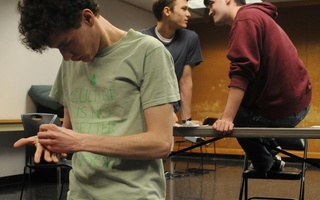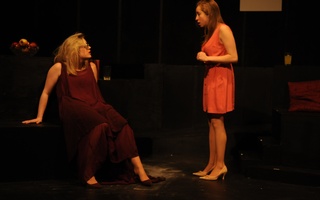Martin McDonagh’s “The Pillowman” is a fairy tale—the kind of fairy tale in which Rumpelstiltskin rips himself in half instead of merely running away at the end. Though dark humor is on par for the course for the writer of “Seven Psychopaths” and “In Bruges,” this play, which runs at the Loeb Mainstage from April 4 to 12, may be McDonagh’s blackest work to date. With precise performances and minimalist flair, Lily R. Glimcher ’14’s production captures with equal success both the comic and the creepy aspects of the play. The result is a show that is simultaneously hard to watch and hard to tear oneself away from.
“The Pillowman” takes place in a “totalitarian fucking dictatorship,” where Katurian (Benjamin J. Lorenz ’14), a writer and latter-day Josef K., finds himself under investigation after a series of child murders mirror with spooky exactitude the content of his twisted stories. When his mentally ill brother, Michal (Taylor A. Cressler ’14), implicates both of them in the killings, Katurian must find a way to save what is most important to him from destruction at the hands of police officers Tupolski (Adam J. Conner ’14, an inactive Crimson business editor) and Ariel (Dorothy C. Donelan ’14)—not himself, not his brother, but his 400 short stories.
As the interrogation progresses, viewers are treated—to use the word liberally—to several of Katurian’s pieces of nightmare-fuel fiction. A child is crucified by sadistic foster parents; a little girl is force-fed apples studded with razor blades; a boy is repaid for his kindness to a stranger by having his toes cut off. In the hands of a less sure-footed production, these grim fairy tales might have been brought to life in a much more literal form, resulting in a stage awash with fake blood and an alienated audience. But Glimcher’s version takes its cues less from Quentin Tarantino than from Michael Haneke, whose film “Funny Games” notably shorthands a main character’s death with nothing more than a red splatter against a television screen. Katurian’s “The Tale of the Town on the River,” for example, is executed with crisp minimalism: a pair of men’s shoes, the swing of a knife, and, across the stage, two disembodied doll’s feet. Other stories are rendered on a stage flooded with light, reducing the figures to mere silhouettes. The effect of these shadowplays is to force viewers to imagine for themselves the horrors they are being narrated, coming up with images that must surely be infinitely more terrifying than anything a cash-strapped student production would have been able to act out. Rounding out the show’s collection of ghoulish tricks are masks and puppets (designed by Glimcher and Alona Bach ’16) that channel the creepy aesthetic of Czech stop-motion animator Jan Švankmajer.
But these visual effects would have been for nothing if the cast had not been as strong as it was. Lorenz delivers a studied, subtle performance whose energy waxes and wanes along with Katurian’s spirit, which now flags in despair, now flares up in anger. Some of the play’s most affecting moments occur in exchanges between Lorenz and Cressler, whose fraternal bond is utterly convincing. Against a background of so much horror, the instances of tenderness between them—when Katurian touches Michal’s face, say, or lovingly cradles his brother’s head—serve as much-needed points of emotional relief for the viewers, the only instances of warmth in an otherwise chilling play.
As two sadistic interrogators, Conner and Donelan are no less successful a pairing. Conner’s Tupolski is the smart-aleck to Ariel’s spitfire, more likely to use a well-placed barb than the electrodes his partner prefers. “Oh, I almost forgot to mention, I’m the good cop, she’s the bad cop,” he deadpans glibly after Ariel slams Katurian against a table. With the easy confidence of a seasoned officer, Conner balances out Lorenz’s panic and Donelan’s violence. The latter started out a tad shaky, with a quaver in her voice that undercut her viciousness. She recovered quickly, however, and later on successfully captured the slow crumble of Ariel’s snarling façade. For all that, however, Donelan is at her most compelling when she’s neither raging nor weeping, but rather briskly doing detective work, attempting coolly to unravel the tales that Lorenz spins for her and her character’s partner.
Justifying his amoral approach to literature, Katurian asserts, “The first duty of a storyteller is to tell a story.” If that’s the case, then McDonagh’s “Pillowman” does its job, and the HRDC’s production of his play more than ensures that his twisted tale will not be forgotten, however much a viewer may like to do so.
Read more in Arts
SO WHAT?!Recommended Articles
-
 The Pillowman
The Pillowman -
 'Pillowman' Anything But Fluffy
'Pillowman' Anything But Fluffy -
Neurotic Hilarity in ‘Play It Again’All men wish they could be Humphrey Bogart—the type of man that ladies swoon over, who can walk away from the beautiful female lead without ever looking back, leaving her with only memories of amorous adventures in exotic locales and one unforgettable parting line.
-
 ‘Trouble’ in Eastwood’s Newest Film
‘Trouble’ in Eastwood’s Newest Film -
‘Psychopaths’ Knows Good Film from BadThe foul-mouthed, rollicking, spaced-out wit that makes “Seven Psychopaths” such a thoroughly entertaining film.
-
 "Raised in Captivity" Captivates
"Raised in Captivity" Captivates













